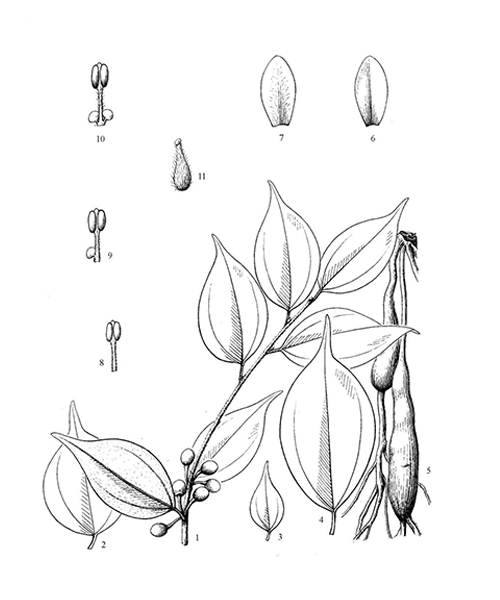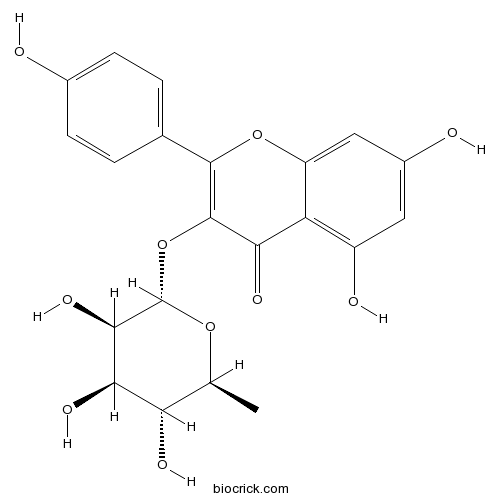Lindera aggregata
Lindera aggregata
1. The products in our compound library are selected from thousands of unique natural products; 2. It has the characteristics of diverse structure, diverse sources and wide coverage of activities; 3. Provide information on the activity of products from major journals, patents and research reports around the world, providing theoretical direction and research basis for further research and screening; 4. Free combination according to the type, source, target and disease of natural product; 5. The compound powder is placed in a covered tube and then discharged into a 10 x 10 cryostat; 6. Transport in ice pack or dry ice pack. Please store it at -20 °C as soon as possible after receiving the product, and use it as soon as possible after opening.

Natural products/compounds from Lindera aggregata
- Cat.No. Product Name CAS Number COA
-
BCN5023
Linderane13476-25-0
Instructions

-
BCN6314
Procyanidin B120315-25-7
Instructions

-
BCN6285
Norisoboldine23599-69-1
Instructions

-
BCN2779
Linderene26146-27-0
Instructions

-
BCN6315
Procyanidin B229106-49-8
Instructions

-
BCN5573
Afzelin482-39-3
Instructions

-
BCN5653
Kaempferol520-18-3
Instructions

-
BCN5771
Avicularin572-30-5
Instructions

-
BCN1251
Linderalactone728-61-0
Instructions

-
BCN1252
Isolinderalactone957-66-4
Instructions

-
BCN4541
Kaempferol 3-O-arabinoside99882-10-7
Instructions

Effect of the serum of rats treated with Suo Quan pill on embryonic stem cells.[Pubmed: 29386153]
Suo Quan pill(SQP), a well-known and classical traditional Chinese medicine compound, consists of three traditional Chinese medicine: Alpinia oxyphylla Miq., Lindera aggregata (Sims) Kosterm., Dioscorea opposite. Its effect was summarized as supplementing kidney-yang and shrinkaging urination. This study evaluated the effects of the serum of rats treated with Suo Quan pill on embryonic stem cells(ES cells). Cell proliferation was detected by MTT assay. Cell cycle and apoptosis of ES cells were evaluated with flow cytometry. Nanog mRNA expression was verified by fluorescence quantitative PCR and Nanog protein in ES cells was determined by Western blot. The serum of SQP-treated rats not only promoted ES cells proliferation and Nanog expression in ES cells, but also inhibited H202 stimulated cell apoptosis. Furthermore, the serum of rats containing SQP affected the cell cycle distribution of ES cells, reducing the percentage of cells in G0/G1phase and increasing the percentage of cells in G2/M phase, increasing the proliferation index of ES cells. These results illustrate that the enhanced effect of SQP on ES cells proliferation is in part due to the increased expression of Nanog in ES cells, the accelerated cell cycle period and the inhibited apoptosis of ES cells.
Urox containing concentrated extracts of Crataeva nurvala stem bark, Equisetum arvense stem and Lindera aggregata root, in the treatment of symptoms of overactive bladder and urinary incontinence: a phase 2, randomised, double-blind placebo controlled trial.[Pubmed: 29385990]
Storage lower urinary tract symptoms (LUTS) including overactive bladder (OAB) and urinary incontinence (UI) affect millions of people worldwide, significantly impacting quality of life. Plant based medicines have been documented both empirically and in emerging scientific research to have varying benefits in reducing bladder symptoms. We assessed the efficacy of Urox®, a proprietary combination of phytomedicine extracts including, Cratevox™ (Crataeva nurvala) stem bark, Equisetem arvense stem and Lindera aggregata root, in reducing symptoms of OAB and UI.
Control of stress-induced depressive disorders by So-ochim-tang-gamibang, a Korean herbal medicine.[Pubmed: 27988398]
So-ochim-tang-gamibang (SOCG) is a Korean herbal medicine formula that has been applied to treat depressive moods and depression associated somatoform pain. This decoction consists of Cyperus rotundus L. (Cyperi Rhizoma), Lindera aggregata (Sims) Kosterm. (Linderae Radix), Aquilaria agallochum (Lour.) Roxb. ex Finl. (Aquilariae Resinatum Lignum), Glycyrrhiza uralensis Fisch. (Glycyrrhizae Radix) Platycodon grandiflorum (Jacq.) A. DC. (Platycodi Radix), and Citrus aurantium L. (Aurantii Fructus). The aim of this study is to assess antidepressant-like effects of SOCG and to investigate its possible cellular and molecular mechanisms.
Kampo Medicine: Evaluation of the Pharmacological Activity of 121 Herbal Drugs on GABAA and 5-HT3A Receptors.[Pubmed: 27524967]
Kampo medicine is a form of Japanese phytotherapy originating from traditional Chinese medicine (TCM). During the last several decades, much attention has been paid to the pharmacological effects of these medical plants and their constituents. However, in many cases, a systematic screening of Kampo remedies to determine pharmacologically relevant targets is still lacking. In this study, a broad screening of Kampo remedies was performed to look for pharmacologically relevant 5-HT3A and GABAA receptor ligands. Several of the Kampo remedies are currently used for symptoms such as nausea, emesis, gastrointestinal motility disorders, anxiety, restlessness, or insomnia. Therefore, the pharmacological effects of 121 herbal drugs from Kampo medicine were analyzed as ethanol tinctures on heterologously expressed 5-HT3A and GABAA receptors, due to the involvement of these receptors in such pathophysiological processes. The tinctures of Lindera aggregata (radix) and Leonurus japonicus (herba) were the most effective inhibitory compounds on the 5-HT3A receptor. Further investigation of known ingredients in these compounds led to the identification of leonurine from Leonurus as a new natural 5-HT3A receptor antagonist. Several potentiating herbs (e.g., Magnolia officinalis (cortex), Syzygium aromaticum (flos), and Panax ginseng (radix)) were also identified for the GABAA receptor, which are all traditionally used for their sedative or anxiolytic effects. A variety of tinctures with antagonistic effects Salvia miltiorrhiza (radix) were also detected. Therefore, this study reveals new insights into the pharmacological action of a broad spectrum of herbal drugs from Kampo, allowing for a better understanding of their physiological effects and clinical applications.
New Benzenoids from the Roots of Lindera aggregata.[Pubmed: 26882682]
Two new benzenoids, linderagatin A and B (1-2), were isolated from the roots of Lindera aggregata. Their structures were elucidated on the basis of 1D (1H, 13C) and 2D NMR (COSY, NOESY, HSQC and HMBC) spectra. Moreover, their absolute configurations were established from ECD spectra compared with previous reports.
Norisoboldine, an Anti-Arthritis Alkaloid Isolated from Radix Linderae, Attenuates Osteoclast Differentiation and Inflammatory Bone Erosion in an Aryl Hydrocarbon Receptor-Dependent Manner.[Pubmed: 26221077]
Norisoboldine (NOR), the primary isoquinoline alkaloid constituent of the root of Lindera aggregata, has previously been demonstrated to attenuate osteoclast (OC) differentiation. Accumulative evidence has shown that aryl hydrocarbon receptor (AhR) plays an important role in regulating the differentiation of various cells, and multiple isoquinoline alkaloids can modulate AhR. In the present study, we explored the role of NOR in the AhR signaling pathway. These data showed that the combination of AhR antagonist resveratrol (Res) or α-naphthoflavone (α-NF) nearly reversed the inhibition of OC differentiation through NOR. NOR could stably bind to AhR, up-regulate the nuclear translocation of AhR, and enhance the accumulation of the AhR-ARNT complex, AhR-mediated reporter gene activity and CYP1A1 expression in RAW 264.7 cells, suggesting that NOR might be an agonist of AhR. Moreover, NOR inhibited the nuclear translocation of NF-κB-p65, resulting in the evident accumulation of the AhR-NF-κB-p65 complex, which could be markedly inhibited through either Res or α-NF. Although NOR only slightly affected the expression of HIF-1α, NOR markedly reduced VEGF mRNA expression and ARNT-HIF-1α complex accumulation. In vivo studies indicated that NOR decreased the number of OCs and ameliorated the bone erosion in the joints of rats with collagen-induced arthritis, accompanied by the up-regulation of CYP1A1 and the down-regulation of VEGF mRNA expression in the synovium of rats. A combination of α-NF nearly completely reversed the effects of NOR. In conclusion, NOR attenuated OC differentiation and bone erosion through the activation of AhR and the subsequent inhibition of both NF-κB and HIF pathways.
Mechanism-based inactivation of CYP2C9 by linderane.[Pubmed: 26068520]
1. Linderane (LDR), a furan-containing sesquiterpenoid, is found in Lindera aggregata (Sims) Kosterm, a common traditional Chinese herbal medicine. We thoroughly studied the irreversible inhibitory effect of LDR on cytochrome P450 2C9 (CYP2C9). 2. LDR caused a time- and concentration-dependent inactivation of CYP2C9. In addition, the inactivation of CYP2C9 by LDR was NADPH-dependent and irreversible. More than 50% of CYP2C9 activity was lost after its incubation with LDR at the concentration of 10 μM for 15 min at 30 °C. The maximal rate constant for inactivation (kinact) was found to be 0.0419 min(-1), and the concentration required for half-maximal inactivation (KI) was 1.26 μM, respectively. Glutathione (GSH), catalase, and superoxide dismutase (SOD) failed to protect CYP2C9 against inactivation by LDR. Diclofenac, a substrate of CYP2C9, prevented the enzyme from inactivation produced by LDR. The estimated partition ratio of the inactivation was approximately 227. 3. Two reactive intermediates, including furanoepoxide and γ-ketoenal, might be responsible for the observed enzyme inactivation. The formation of the intermediates was verified by chemical synthesis. Multiple P450 enzymes, including CYPs 1A2, 2B6, 2C9, 2C19, 2D6, 3A4, and 3A5, were found to be involved in the metabolic activation of LDR. In conclusion, LDR was characterized as a mechanism-based inactivator of CYP2C9.


